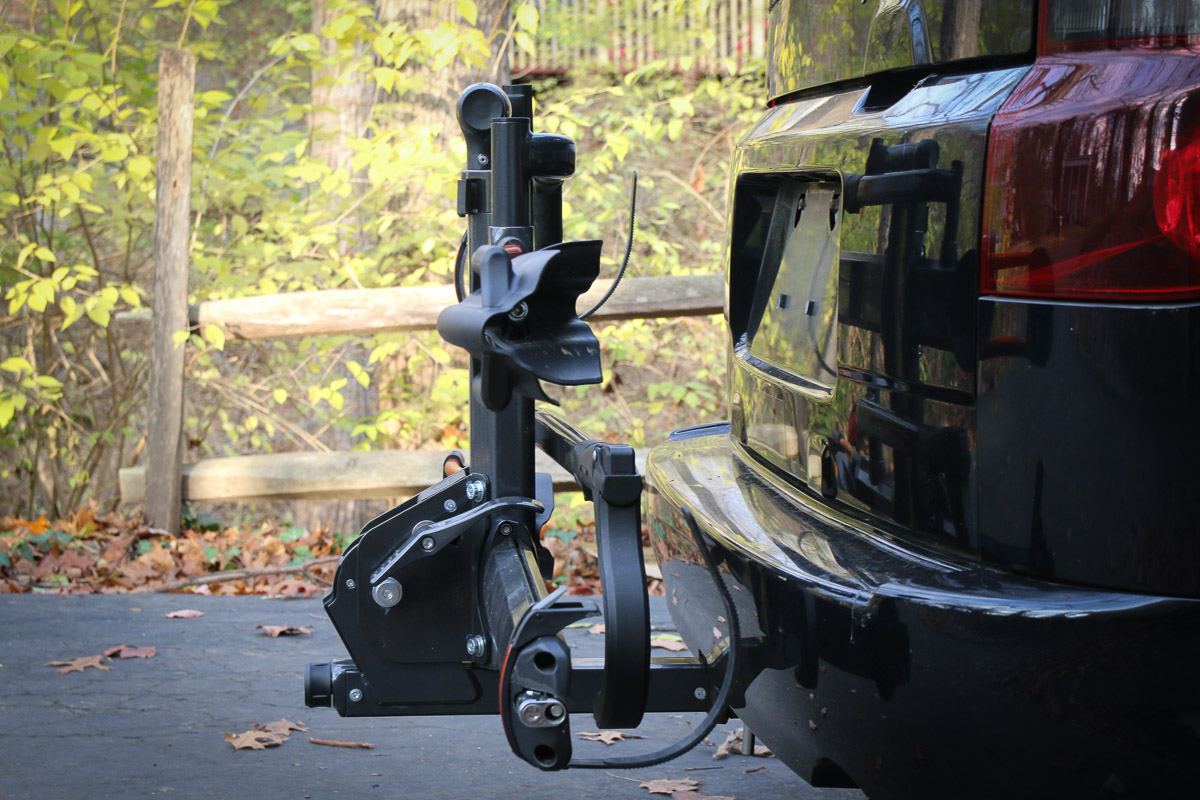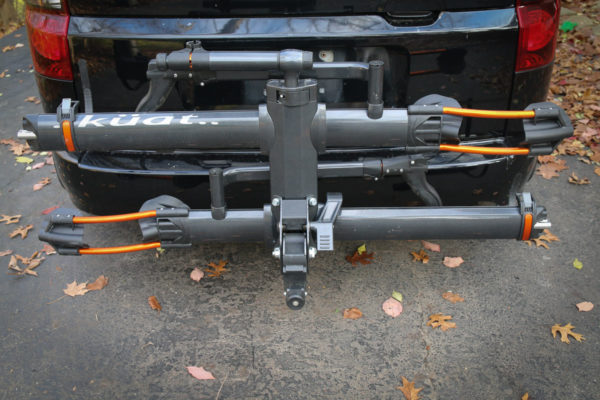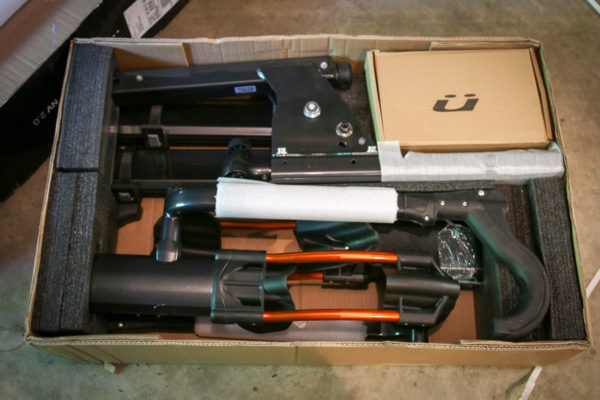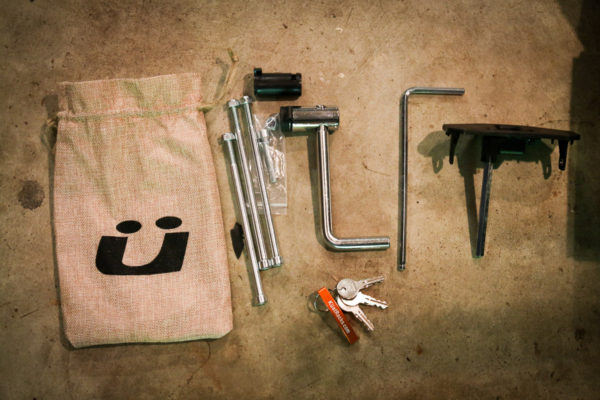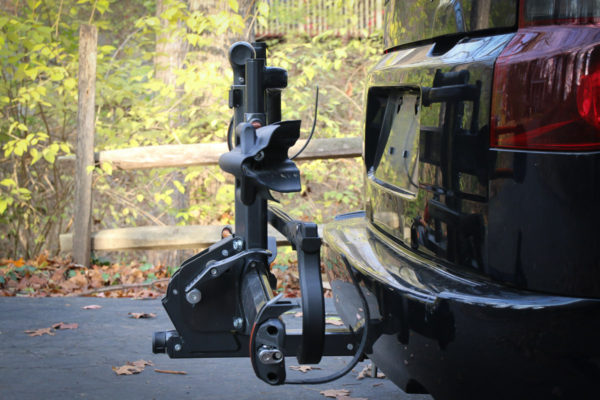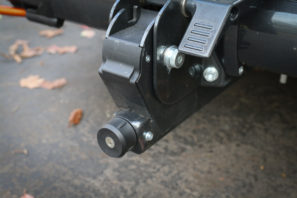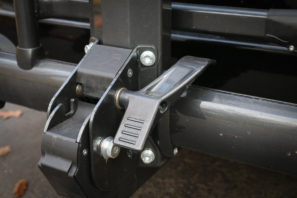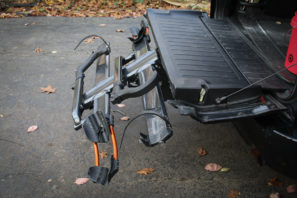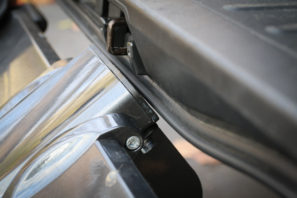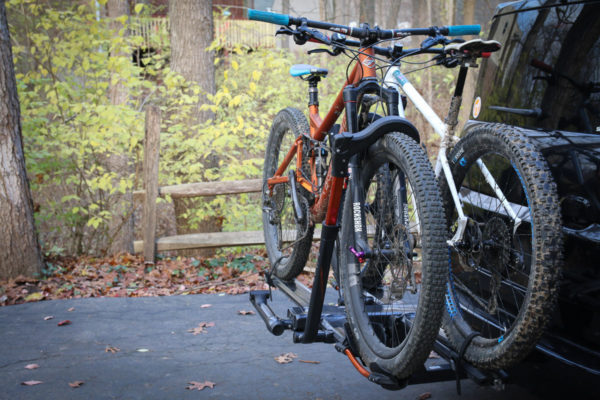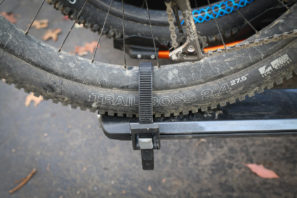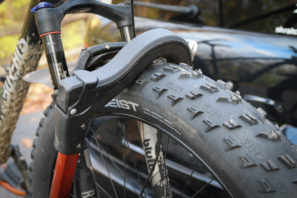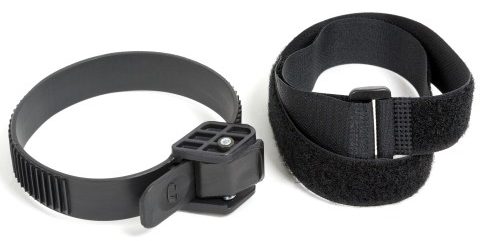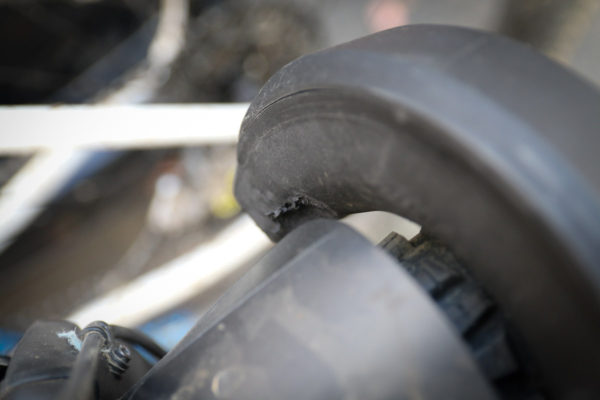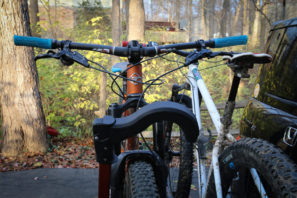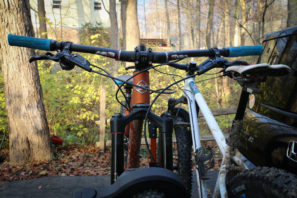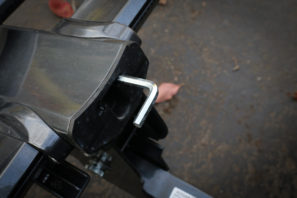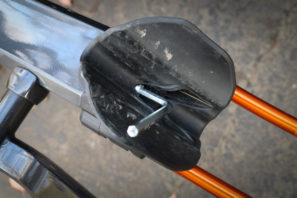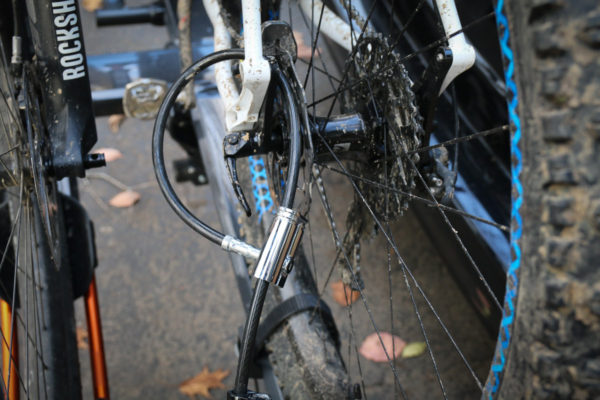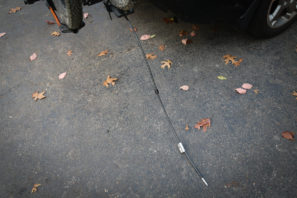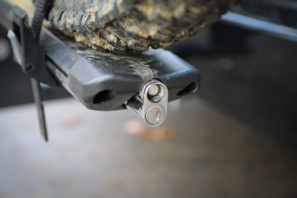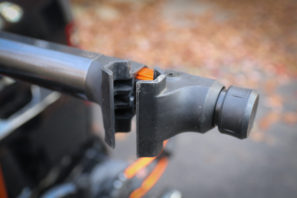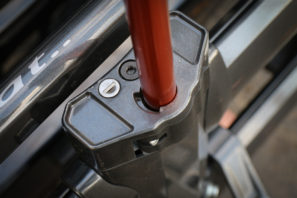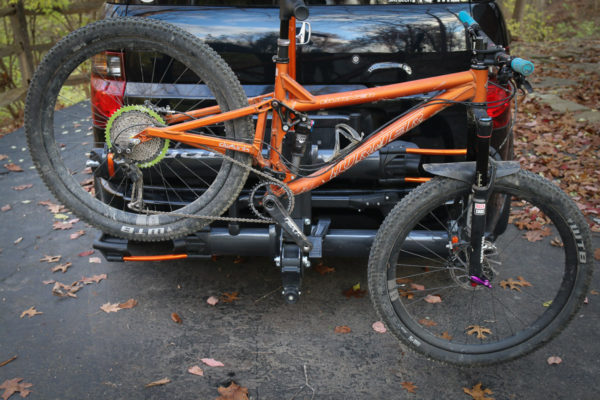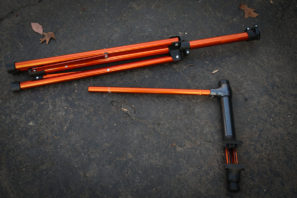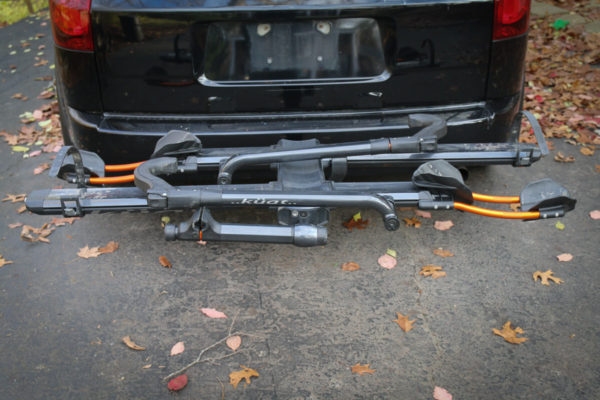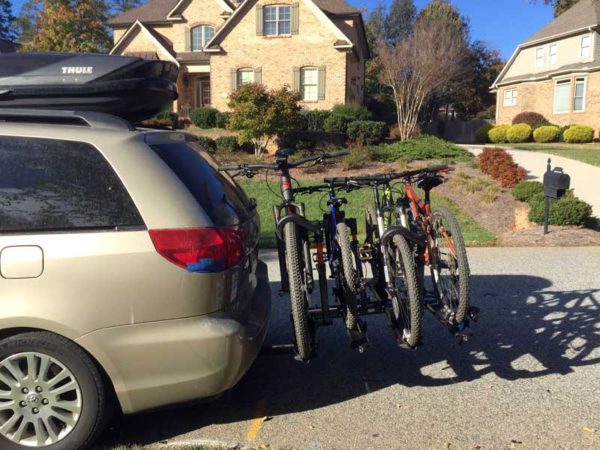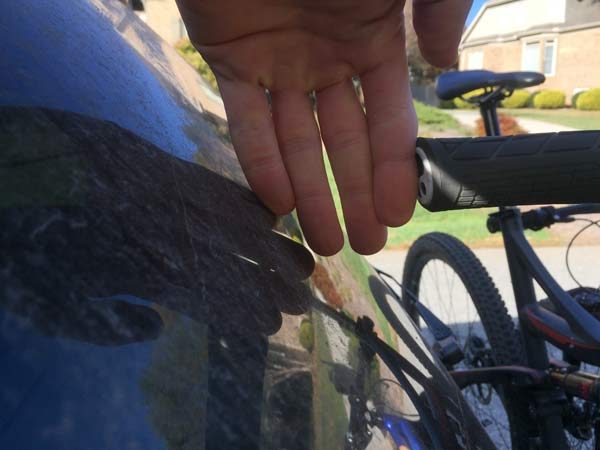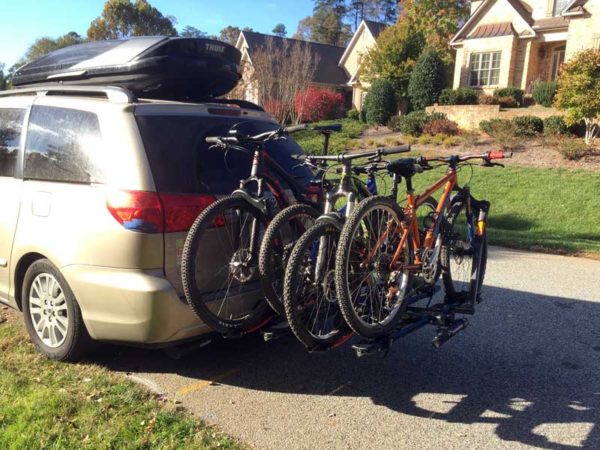Küat has always been easy to spot. When they first rolled onto the scene, the Küat NV was the rack that everyone seemed to want. It had unique style, unique features, and a sleek design. Since then, other manufacturers have been catching up, but now Küat is back with the NV 2.0. In addition to building on the iconic style that set it apart in the first place, the new rack was built to be better in almost every way…
Arriving packed neatly in its box, the NV 2.0 does require a bit of assembly. Nothing too complicated, and the required tools are included in the box (along with spare keys and a bottle opener key chain, of course). The assembly is straight forward, but you do want to make sure the bolts that hold the trays together are super tight. After the initial installation I had a bit of play in one of the trays, but going back and using the long end of the allen wrench to make sure it was completely tight eliminated any play.
Like many hitch racks, the Küat NV 2.0 folds up when not in use. The hing mechanism protrudes a bit from the base, but the rack is still much shorter in the upright position. At the end of the rack is the hitch cam system which tightens the rack stinger into the hitch without tools. If for some reason you lack the hand strength to fully tighten it, there is an allen bolt in the center just in case. The cam system makes a threaded hitch pin unnecessary, so the rack is locked to the car with a simple L-shaped hitch pin and heavy duty lock core.
In addition to the burly overhaul of the main pivot, the rack also includes the ability to use your foot to actuated it when it’s in the upright position. I was surprised to find how much I enjoyed this addition due to the fact that every time I grabbed a bike to put on the rack, I would usually forget to put the rack down first. The foot pedal allows you to hold onto the bike with one hand, hold onto the rack with the other, and then actuate the lever with your foot so you never have to put the bike down. The lever is also quite well designed to use with your hands when the rack is flat, making it a joy to use.
Always important (to me at least), is how racks interface with my Honda Element. I want to be able to fold down the lift gate and sit on it without worrying that a rack is digging into the paint. I’m super happy that the Küat NV 2.0 clears the gate – though just barely. The part that looks like it’s touching is a rubber seal, and you can jump up and down on the tailgate without it touching anything solid. In order to make this a reality though, you do have to make sure you install the rack correctly – put the stinger into the hitch, insert the hitch pin, then pull back on the rack to make sure it is as far out as possible, then tighten the cam mechanism. The clearance is so tight that if you fail to do that, the rack will touch the lift gate.
While the rack has a similar feel to the original NV, the 2.0 clamps to the bikes with all new, more robust parts. Up front, the front tire ratchet has a new design with an easy to use push button release and clearance for up to 4.8″ fat bike tires. Out back, a new co-molded tire strap slots into a sliding channel to adjust for different wheel bases. Küat claims the rack will fit up to 48″ wheel bases, and 20-29″ tires (20-24″ tires require a special wheel adapter).
They also state that the rack is capable of carrying fat bikes, but that is only with the addition of the Küat Phat Bike Kit. Originally, the rack was going to fit fat bikes without adapters, but Küat decided that most people wouldn’t want the excess strap floating around when they’re not carrying fat bikes so they went back to the extension. Each Phat Bike Kit includes an extension for the rear ratchets strap, and an additional velcro strap to provide extra security for the front wheel in the tray. My rack did not include them which is why I had to to use a stock photo, but I received one of the very first rack shipments. Since then, Küat has decided that each rack will ship with one Phat Bike Kit and once users register their rack with Küat they will receive a coupon code for another one, free from the Küat web store.
Ok, this is a bad photo and the Turner was the wrong bike to use since it has a fender, but the one negative of the rack has to do with the soft rubber on the tire ratchet. That chunk missing is actually from the bolt on hose guides common to many suspension forks. Küat says to place the tire arm as close to the front fork as possible, and when you do so, that bolt ends up rubbing against the arm and digs into the rubber quite a bit. So far it hasn’t become an issue, but it’s something to keep an eye on.
It’s also worth pointing out that Küat very specifically says in the instructions to not use the rack on a bike with a front fender. So don’t do it. With that said, I have been able to use it with the flexible plastic fenders common to mountain bikes without any issue (though these fenders also dig into the rubber of the arm).
One of the more interesting features is the ability to pitch the front wheel tray to raise or lower the front end of each bike to theoretically eliminate interference between the bikes. An allen wrench that is stashed in the back of the rack can be used to adjust the 8mm bolt, and a quick turn allows you to adjust the cradle up or down, and then snug it back up. Shown above in the first picture, I couldn’t even get the Turner vertical because the brake lever hit the saddle. After adjusting the tray, the bike slotted into place with the lever now over the saddle (though it did just barely touch). The system does work, though I didn’t find myself using it much – most of my bikes that have clearance issues are mountain bikes, and now that dropper posts are commonplace, you just drop the post. Problem solved. Mostly.
Even though it’s certainly not high security, the integrated locking cable is a nice touch. The telescoping cable extends from the end of each tray and is long enough only to lock around the frame of your bike. Not what I’d use to leave bikes outside for an extended period, but on countless occasions where I had to run into a store or restaurant after a ride it was easy peace of mind. A nice touch is that you don’t need the key to lock it – just push the cable into the lock and it locks itself. Then use the same key as the rest of the rack to unlock.
As far as I know, Küat is still one of the only companies to offer an integrated repair stand on their hitch rack (though my roommates had the same idea in college – true story). On the 2.0, everything has been upgraded. There is a new clamp head with a quick release sliding action, a locking quick release lever on the rack to control the height, and even an accessory base tripod to turn it into a true repair stand. To make everything light and portable, the stand does use smaller diameter tubing than most repair stands so it’s not quite as robust, but for quick repairs trail side, it’s hard to beat. The tripod obviously makes repairs a bit easier and gets the bike higher off the ground, but it can’t beat the convenience of having it ready to go on the back of your car. Either way, it’s a neat feature that may not see a lot of use, but you’ll be happy it’s there when you need it.
The NV was already a nice rack, but there is no doubt that the NV 2.0 is better. Much better. In terms of ease and speed of installing bikes onto the rack, it’s one of the best. There are racks out there that provide a little more stability to the bike while transporting it, but not with the simplicity the NV 2.0 affords. The rack not only looks good from a styling point of view, but the finish and all of the bolts still look great after a season of use. By now, in my experience usually most racks will start showing signs of rust and dulling of the finish.
TYLER’S TAKE: I’ve been running the NV 2.0 for a much shorter time than Zach, but I’ve been using it with the two-bike extension to carry a family’s worth of mountain bikes to and fro. About six years ago, I tried the original NV in a four-bike configuration and, while it looked really good, it wasn’t my favorite for one main reason: The release buttons sucked. They were a small button that you depressed to lift the arm off the tire, and they tended to get stuck or not work after a while. This new version uses larger buttons that are more like levers, pushing sideways rather than down into the arm. Not only to they work much, much better, but they make it even easier to do one handed. That, and the arms slide up and down more smoothly.
I’ll second most everything Zach said, even adding that I found the rack to be very stable even with a full load. I did push the arms down onto the front tire firmly, though, because I absolutely needed to prevent bike wobble. Why? Because they sit very close to the rear window. This was an issue with the original, too, and if you’re vehicle has a more upright rear end (like, say, a full size SUV), it might be worth test fitting at a shop before committing. Our Toyota Sienna’s rear window curves forward, and still there’s only about 3″ between my handlebar (740mm wide, plus a few mm more for the Ergon Enduro grips’ angled ends). If you run wider bars, it’ll be even closer. To be fair, the hitch on the Sienna sits pretty far under the vehicle, and there’s a second pin hole further back, but the included Kuat lock pin won’t fit through it. Other brand’s racks offer a bit longer stinger, and even an extra half inch would be appreciated.
I also found that it fit 24″ mountain bikes just fine, as shown above. The middle two bikes are youth models from Specialized and Trailcraft, both 24″, and they were held securely. Any 24″ road bikes might be a different story, and you should use your own judgement (and probably just register the rack and get your free adapters). The other bikes are an XL Pivot Mach 429SL, which represents a very long wheelbase but fit just fine, and an older Kona 26″ hardtail.
I agree that the one-handed operation is amazing. The hinge mechanism is the smoothest and easiest I’ve ever felt on any rack, and even with the extra length and heft (yes, it’s quite heavy) of the four bike model, it’s easy to lift and lower. The updated workstand attaches much more securely than before and its adjustment dials and locking button are welcome improvements, too. Overall, this is an amazing rack, and it comes in all black, too.
BACK TO ZACH: With two-bike racks in 1-1/4″ and 2″, and a 2″ version that can carry four bikes with the two-bike Add On, the NV 2.0 is an incredible rack – as long as you can get over the price. Starting at $649 with another $429 for the NV 2.0 Add On, the rack ain’t cheap, but a premium rack usually includes a premium price. I will say that if the finish (including bolts) continues to hold up as well as it has, then it’s worth every penny.
TYLER: There’s also a new budget model that knocks a little off that by limiting the bonus features. Details, along with pics of the blacked out version, in our Interbike coverage.
